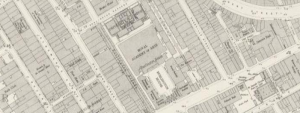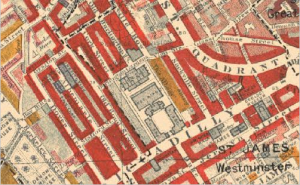 The Royal Academy of Arts located in Picadilly was founded in 1768 with the intention of cultivating and improving the arts of painting, sculpting, and architecture. The two main objectives of forming the Academy were to create a “well-regulated” school of design and to host an annual exhibition “to all artists of distinguished merit.” The Royal Academy’s active members (which vary in number time-to-time) are split into Academicians, Associates, and Associate Engravers. The Academicians are painters, sculptors, architects, and engravers. There are also Honorary Members, Honorary Retired Members, and Honorary Foreign Academicians. All members “whose work shows sufficient merit are permitted to contribute to its exhibitions” (Victorian Art).
The Royal Academy of Arts located in Picadilly was founded in 1768 with the intention of cultivating and improving the arts of painting, sculpting, and architecture. The two main objectives of forming the Academy were to create a “well-regulated” school of design and to host an annual exhibition “to all artists of distinguished merit.” The Royal Academy’s active members (which vary in number time-to-time) are split into Academicians, Associates, and Associate Engravers. The Academicians are painters, sculptors, architects, and engravers. There are also Honorary Members, Honorary Retired Members, and Honorary Foreign Academicians. All members “whose work shows sufficient merit are permitted to contribute to its exhibitions” (Victorian Art).
The Royal Academy chooses its members as so: Associates are chosen through election. Those eligible for election are exhibitors, who are chosen by Academicians at the annual meeting at the Academy. The Academicians are chosen from the associates when a spot opens. As the Royal Academy was established through a charter, as a memorial for George III, all elected individuals must be given the signature of the reigning sovereign. Therefore, no individual membership within the Royal Academy is valid unless approved by the monarch (Victorian Art).
Because the Academy is a Royal establishment, it is unsurprising that those who live in its surrounding neighborhoods are either middle or upper class. Unlike many other areas we’ve looked at, there is no lower middle class or poor inhabitants mixed in. This may be why the crime in the area is so low to nonexistant. While searching the Old Bailey, I found no records of crime related to the Royal Academy.
How does this relate to the story?
In Chapter 9, the first paragraph mentions that Frank “had invited all the people he knew in London to inspect his pictures and Mr. Oakley’s before they were sent in to the Royal Academy” (111). It is the mentioned that Mr. Oakley isn’t necessarily all that talented or sought after, but that his pictures make it into exhibition and are sold. Because both Frank and Mr. Oakley are artists whose work is shown in the Royal Academy exhibition, it is implied that they are very wealthy.
Works Cited
“Victorian Art Institutions: Academies, Schools, Galleries.” The Victorian Web. N.p., 20 July 2015. Web. 27 Oct. 2015.

